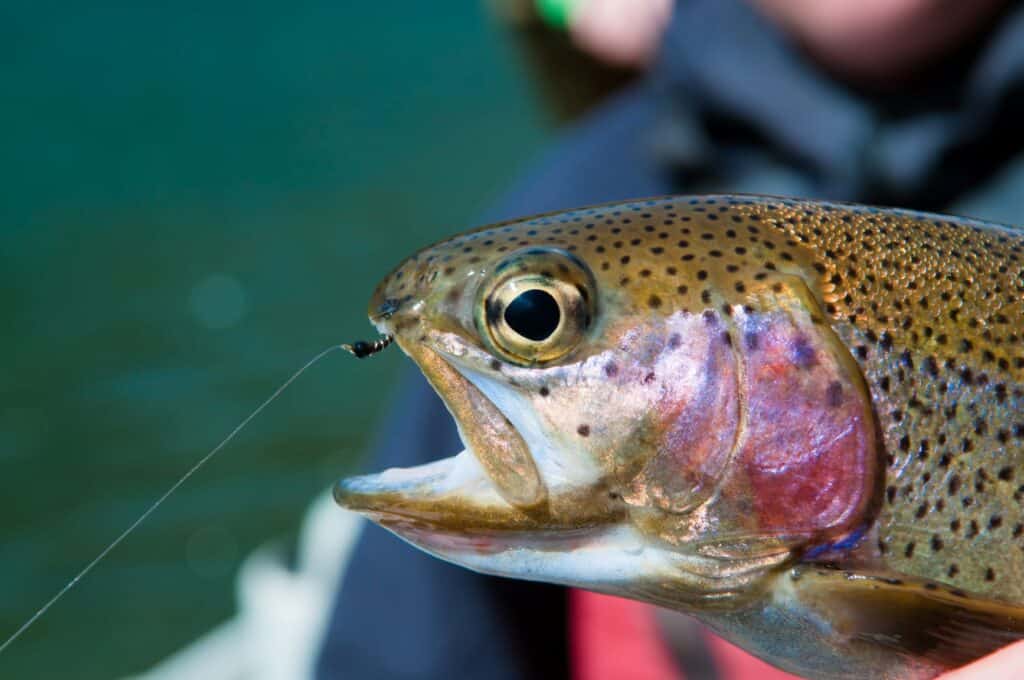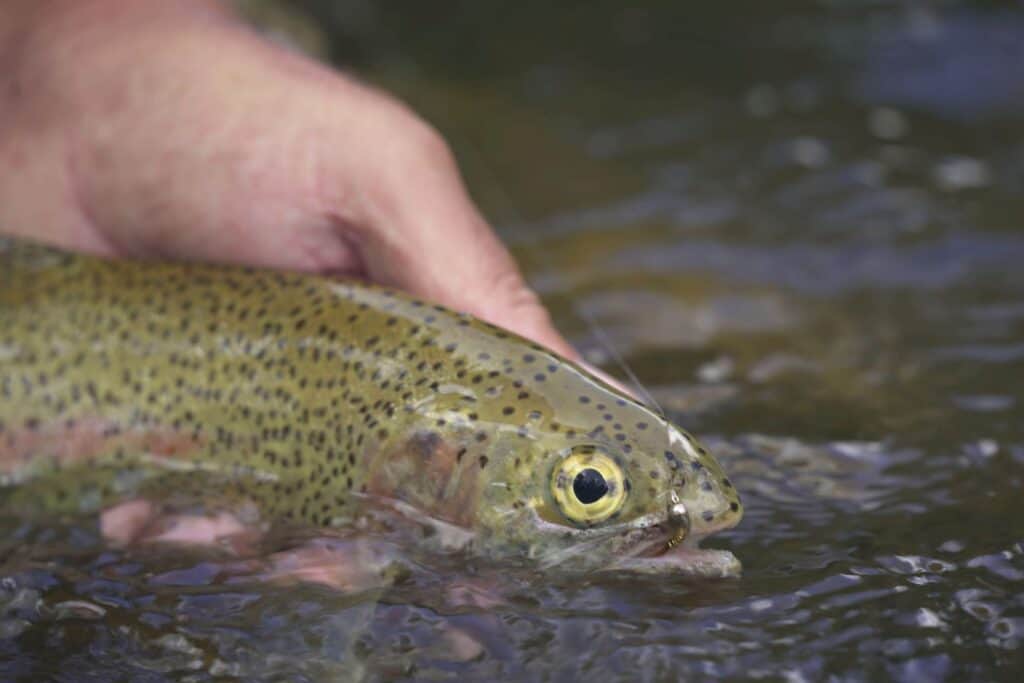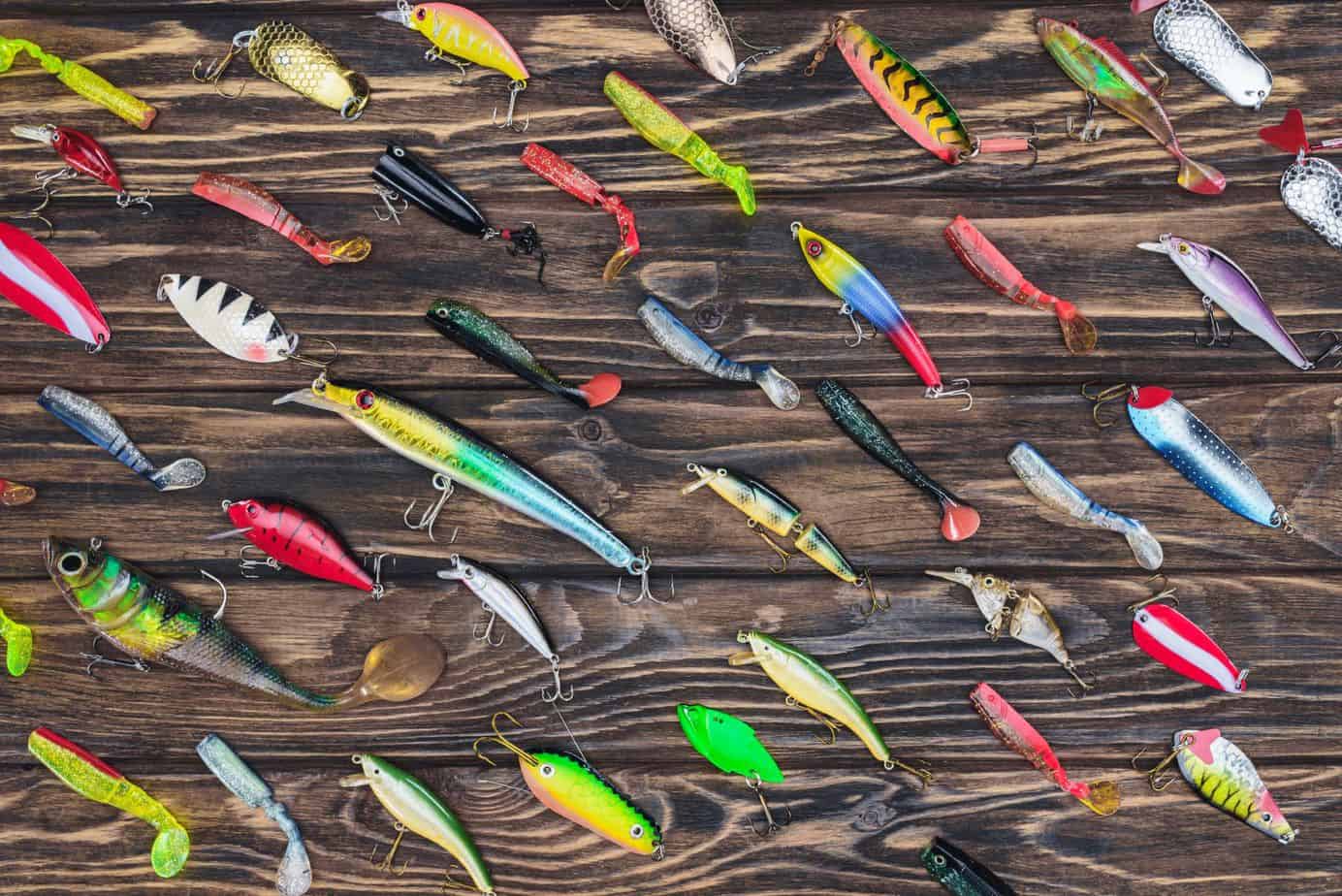For most fly fishermen and women cracking the code of the best baits to use when locating rainbow trout is a never-ending cycle of research and experimenting, with good reason too.
Rainbow trout can be finicky eaters while only feeding on specific baits depending upon the season, weather, and location. Before loading all your gear up to hit the local river, be sure to check your local hatch conditions to most accurately represent the natural food source for these sometimes elusive fish.
In this article, we will talk about a few secret rainbow trout baits that you may have never heard of, along with the conditions these baits prove most successful. Paying close attention to feeding patterns and water temperature is a great first place to start choosing one of these flies to tie on during your next fishing adventure.
Squirmy Wormy Flies
As you can probably tell by the title, Squirmy Wormy flies mimic a nightcrawler or oversized midge larva’s look and action. These flies are specifically designed to entice fish to feed right after a rainstorm or once snow runoff has begun at the start of spring. Both of these scenarios can push worms and larva from the riverbanks into the water, where rainbow trout are eagerly awaiting their next meal.
Much like fishing a standard nymph, Squirmy Wormy flies should be dead drifted down a stream or cast behind a structure where the current slows down enough for trout to congregate behind when resting. Adding a bit of weight to your setup will allow this fly style to run along the bottom of the riverbed and move freely through the water column at a reduced speed while putting your bait directly in the eyesight of fish.
Squirmy Wormy flies are a phenomenal transition between bait fishing and fly fishing while combining techniques of both. If you plan on trying your hand at fishing with Squirmy Wormy flies, be sure to check your local regulations on where you are allowed to fish a rubber-based fly as many streams and rivers forbid them.
Berkley PowerBait
Now PowerBait may not be a total secret. Not many people know just how effective it can be! Berkley designed PowerBait to mimic the food that stocked trout eat while in the hatchery and comes in a wide range of colors to match any feeding conditions. Once rainbow trout are stocked into a body of water, It is common practice to start searching for a food source that seems natural to them. That’s where PowerBait comes in handy.
PowerBait is an easy-to-mold naturally floating bait that can be formed around a hook for a tasty presentation. Novice and experienced anglers alike have been using PowerBait for years with proven success. PowerBait is fished the same way you would fish most other “live” baits or floating flies.
Using a bit of PowerBait on your already tried and true flies can draw quicker strikes thanks to the thick aroma produced from this bait. Adding a little weight, such as a split-shot sinker, to your setup will allow the PowerBait to rest below the surface of the water while pairing nicely with a classic strike indicator to let you know when it’s feeding time.

Canned Corn
Just when you think you have tried everything and still haven’t landed that prized rainbow trout, putting a single kernel of canned corn on your hook might just be the answer! Going along the same theme of the PowerBait, corn kernels are a very similar shape and size to the pellets typically fed to rainbow trout in the hatcheries before being healthy enough to be stocked in local waterways.
Growing up in a hatchery creates a natural desire for trout to feed on food fed to them throughout their life from birth. Using baits such as canned corn triggers this instinctual response to strike. While many other fish species will also feed on a nice piece of corn, trout are by nature more inclined to feed on corn than others.
Air Injected Worms & Maggots
Although live worms and maggots are known for being impressively consistent when fishing for rainbow trout, some anglers take this simple concept and adapt it to fit their preferences. Some anglers take it as far as bringing syringes along with them to the fishing spot to inject a small amount of air into their worms or maggots.
Injecting your worms or maggots with a bit of air allows them to float on the surface of the water, enticing the topwater strikes. Rainbow trout are opportunistic feeders and will strike on all sorts of objects that fall into the water, especially meals that float right past. This technique of injecting air into live bait is used by fly fishermen and conventional fishermen alike based on its success rate. While it may seem a little strange to carry syringes among your fishing gear, it may just be one of the best secret baits for rainbow trout out there.
Rapala CountDown Lure
For lovers of the classic conventional rod and reel approach, the CountDown lure from Rapala is a must-have for every fisherman who targets rainbow trout. This specially designed lure slowly sinks beneath the surface water at a rate of 1 foot every second, letting you fish any depth consistently.
The CountDown lure mimics baitfish while enticing larger rainbow trout to strike once the lure has reached the feeding zone. Perfect for trolling or casting from shore, you can fish this lure in many different ways. Coming in a wide variety of color and size options, the CountDown lure can catch more than just trophy-sized rainbow trout.

Salmon Eggs
Much like other fish species, trout are cannibalistic and will often feed on younger trout and the eggs during the spawning season. Salmon eggs are just as desirable as trout eggs but are more readily available on a much larger scale. Since salmon eggs are naturally buoyant, floating them downstream into large pools holding trout can be surprisingly successful.
Adding a bit of weight to your setup can get your salmon eggs below the surface of the water to reach suspended rainbows. There are a few techniques to rigging up salmon eggs for bait, but the most common by far is to use a small hook loaded up with a couple of eggs. It is important to note salmon eggs are very fragile, causing them to fall off the hook almost immediately after a bite if the fish isn’t hooked up.
Checking your bait often between bites will ensure you do not have an empty hook sitting out in the water for too long. Some anglers will wrap multiple eggs into a mesh sack to provide a more desirable presentation while allowing more strikes from an interested rainbow trout.
Shrimp
Out of all the examples in this list of best secret rainbow trout baits, shrimp might just be the most underrated bait of them all. Just when you think you have tried everything and still cannot manage to draw a bite, hooking up a piece of fresh or even cooked shrimp could be your saving grace.
Shrimp are naturally a very aromatic bait, and this feature alone makes it a great bait to use in overfished waterways or places that are generally hard to produce strikes. Although it still has not become standard practice for even some of the most experienced fishermen, anglers have been known to use shrimp as rainbow trout bait for years.
Similar to using salmon eggs, shrimp can fall off the hook comparatively easier than other types of live bait and should be checked frequently between bites. Using a small baitholder hook with a bit of weight will help reach those monster rainbow trout. Live shrimp will move around in the water on their own, adding to the action drawing in curious fish. The combination of smell and action makes shrimp one of the most deadly secret baits for rainbow trout out there.
Conclusion
While almost every fisherman has that secret bait to use when fishing for rainbow trout, experimenting with a couple of these baits from our list can result in more fish landed and more smiles to be had. Paying close attention to feeding patterns along with the spawn will give you a better idea of what works and what does not work, but nothing beats getting out on the water to see for yourself. Sometimes it takes a bit of out-of-the-box techniques to hone in the skills required to start successfully landing consistent fish.
If you find this article helpful, don’t leave without sighing up for our newsletter and checking out our Recommended Fly Fishing Gear List.
Don’t forget to check out our other Fish Guide articles.
- Are Bass Good To Eat?
- What’s the Difference Between Trout and Salmon?
- Are Bonefish Good To Eat?
- What’s the Difference Between Carp and Buffalo Fish?
- Are Pike Good To Eat?
- The 7 Best Secret Rainbow Trout Baits
- Best Powerbait For Stocked Trout
- What Is The Difference Between Walleye And Pickerel?
- What Is A Tiger Trout? Where to Find One and How To Catch One


